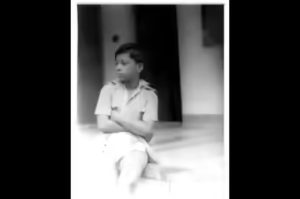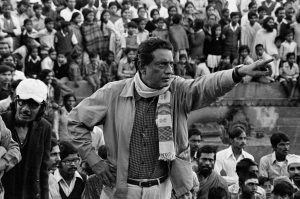Echoes of Pancham: A quiet but powerful citizens’ movement is gaining momentum in Kolkata to preserve the childhood home of legendary music composer Rahul Dev Burman, popularly known as Pancham. Located at 36/1 South End Park, the art-deco bungalow was once a vibrant hub of musical creation shared by Pancham and his father, the great S.D. Burman. Now abandoned, structurally decaying, and at risk of demolition, this historic site is at the center of a growing campaign urging government authorities and heritage bodies to intervene before it’s too late.

Echoes of Pancham: The House That Music Built
Built in the 1940s by S.D. Burman, the modest two-storey house served as the family’s residence for over a decade. It was here that a young R.D. Burman took his first musical steps — playing the harmonica, listening to classical sessions held in the drawing room, and accompanying his father on harmonium.
The house also hosted cultural icons such as Ustad Allaudin Khan, Salil Chowdhury, and others who would go on to shape modern Indian music. Several early compositions that would later become film classics were rehearsed within its walls. The environment was charged with experimentation, rhythm, and lyrical invention.


Neglect and Structural Decline
In the years following the Burman family’s move to Mumbai in the early 1950s, the house changed ownership. Over time, lack of maintenance and ambiguity over its future left it vulnerable. Today, it stands in a fragile state — with broken plaster, leaking roofs, and overgrown surroundings.
Portions of the structure, particularly the balcony and upper floor facade, have started to show signs of collapse. Cracks run across the main walls, and the courtyard — once filled with musical echoes — lies buried under debris.
Despite its cultural value, the house has not been restored or protected as a heritage site, leaving its fate uncertain.
Campaign to Preserve the Site
The push to save the house has been initiated by documentary filmmaker Abhijit Dasgupta, who is also a relative of the Burman family. Through online campaigns, public appeals, and awareness efforts, he is urging the state government and heritage conservationists to preserve the building.
“It’s more than just brick and cement. It’s a repository of India’s cultural memory,” Dasgupta said in a statement. “We’ve already lost too many such sites to apathy. We must not lose this one.”
The campaign seeks to have the house declared a protected heritage structure under the West Bengal Heritage Commission Act. A growing number of artists, musicians, and cultural enthusiasts have joined the appeal, urging the government to act swiftly.
Administrative and Legal Background
In 2006, Kolkata Municipal Corporation categorized the house as a Category IIB heritage structure, which offers partial protection. However, that status alone does not prevent alteration or sale unless the owner agrees or the government steps in with conservation funding.
As of now, the property is in private hands. The current owners — the Totla family — have not made public statements about its future. However, there are unconfirmed reports that the structure could be sold or redeveloped, which has intensified calls for government acquisition.
Heritage activists argue that unless the house is brought under the full conservation framework with funding allocated for restoration, its future remains uncertain.


Vision for Restoration
Campaigners are proposing a collaborative public-private plan to convert the house into:
- A music heritage museum dedicated to the legacy of S.D. and R.D. Burman.
- An archive space for rare records, photographs, and letters.
- A cultural centre for local musicians and students of Indian music.
This vision aligns with similar efforts in Mumbai, Chennai, and Goa, where heritage homes of prominent cultural figures have been converted into public art spaces.
Public Response and Cultural Sentiment
The movement has sparked emotional responses across generations of music lovers. Kolkata, a city known for cherishing its cultural icons, has witnessed a steady rise in citizen-led heritage advocacy. Many recall how past neglect led to the loss of other landmarks — from playwright Utpal Dutt’s house to parts of Tagore’s old residence in Jorasanko.
Musicians and film personalities have added their voices, emphasizing the need to protect such spaces as sites of collective memory.
“This is where Pancham Da found his rhythm. Saving it is our tribute to his music,” said a local sarod player who grew up listening to R.D. Burman’s records.
Challenges Ahead
While public interest is surging, bureaucratic and legal hurdles persist:
- The house is privately owned, meaning government intervention must follow a legal acquisition or conservation agreement.
- Funding remains a significant issue. Restoration of aging buildings requires architectural studies, safety measures, and considerable cost.
- Political will and coordination between state agencies like the West Bengal Heritage Commission, KMC, and cultural departments is essential to prevent delays.
What Can Be Done Now?
To build momentum, campaigners suggest the following steps:
- Official Survey and Report: A structural report prepared by the KMC or an approved heritage architect.
- Public Hearing: Inclusion of residents, artists, historians, and civic bodies in a transparent consultation process.
- Temporary Measures: Emergency stabilization to prevent further collapse.
- Long-term Plan: Heritage museum and cultural space with community ownership or public-private partnership.
External Resources
- Kolkata Municipal Corporation (Heritage Wing): https://www.kmcgov.in
- West Bengal Heritage Commission: https://wbhc.gov.in
- Indian National Trust for Art and Cultural Heritage (INTACH): https://www.intach.org
- Heritage Laws of West Bengal (PDF): https://www.wbhc.gov.in/pdf/heritage-rules.pdf
Conclusion
The house at 36/1 South End Park is not just a physical structure. It is a living testimony to India’s musical evolution and to a son of Bengal whose compositions continue to enchant listeners worldwide. As calls to preserve it grow louder, the responsibility now rests on civic authorities and citizens alike to act before the echoes of Pancham’s childhood are silenced forever by inaction.
Also read: Home | Channel 6 Network – Latest News, Breaking Updates: Politics, Business, Tech & More

